#Masillaraptor
Text
Fossil Novembirb: Day 8 - Raptors Are Back

Once the Cenozoic had begun, the only remaining dinosaurs were modern birds. That means raptors (or dromaeosaurs) would never again stalk the Earth, right? Wrong! Raptor dinosaurs get their name from modern raptors: eagles, hawks, owls and the like; and they are in fact some of the closest relatives of birds. So during the Paleogene period when predatory birds started to radiate, they weren't reinventing being a raptor. They continued being raptors.
Palaeoglaux: An early owl from Germany's Messel Lake, about 40 million years ago. Unlike modern owls, it had strange ribbon-like feathers on its body, likely used in display.
Horusornis: A strange relative of hawks and eagles that lived in France 35 million years ago. Like modern harrier-hawks, it had flexible feet to dig out prey from tree cavities.
Antarctoboenus: An early relative of falcons found from Antarctica, about 35 million years ago. It may have prowled near the edges of giant penguin colonies.
Danielsraptor: Another early falcon from the 50 million year old London Clay formation. It had a large jagged beak and long legs, which helped it catch prey on the ground.
Dynamopterus: A relative of Seriemas and terror birds from Messel lake, about 40 million years ago. It likely caught small vertebrates from the forest floor.
Paleopsilopterus: One of the earliest known terror birds, it lived in Brazil about 50 million years ago. It was already flightless and similar to later small terror birds.
Bathornis: A distant relative of terror birds that was remarkably successful. This flightless predator and its relatives lived in North America from the Late Eocene to the Oligocene.
Messelastur: A falcon-like bird of prey that was closely related to parrots and passerines instead of raptors. It lived in Messel Lake about 40 million years ago.
Masillaraptor: A tiny true falcon also known from Messel Lake. It had a relatively long beak from a falcon, and it may have fed mostly on large insects.
Tynskya: Another small raptor related to parrots and passerines, this falcon-like predator lived around 50 million years ago. Its remains have been found in North America and Europe.
#Fossil Novembirb#Novembirb#Dinovember#birblr#palaeoblr#Birds#Dinosaurs#Cenozoic Birds#Palaeoglaux#Horusornis#Antarctoboenus#Danielsraptor#Dynamopterus#Paleopsilopterus#Bathornis#Messelastur#Masillaraptor#Tynskya
76 notes
·
View notes
Text
Fossil Novembirb 11: A New Dawn

Palaeotis by @drawingwithdinosaurs
One of the absolutely best known ecosystems of the Eocene is found at the Messel Pit site of Germany. Deposited in a similar way (via multiple volcanic eruptions over periods of thousands of years) to the Fossil Lake of yesterday, but a few million years later, it shows the end of the early Eocene and the start of the emergence of modern mammalian groups. Lucky for us, it also shows the next stage of bird evolution! This was also the site featured in the first episode of Walking With Beasts, "A New Dawn", though the avifauna was not particularly well represented in that program.
Yes, obviously, Gastornis was in Messel, though as a large ground herbivore than a predator. But there were plenty more birds than that! Lithornis was also here, because it was just as ubiquitous; and there was also the mysterious Palaeoganth Palaeotis. Originally thought to be a relative of Ostriches, then not, and now possibly again, this bird has a strangely intermediate morphology between that of large flightless Palaeognaths and the Lithornithids of the early Paleogene; indicating it may be a transitional form. It would not have been able to fly, given its short wings and lack of keel, and probably fed on small animals in its environment.

Juncitarsus by @thewoodparable
In addition to the Megafowl Gastornis, there was also the early landfowl Paraortygoides, which did not have a crop like living landfowl and as such probably mainly fed on soft plant material. It also had shorter legs than other landfowl relatives at the time, indicating it may have been more similar to living pheasants than fowl that had been around previously.
Even though the Flamingo-Ducks like Presbyornis would stick around well into the Neogene, the first relatives of Flamingos show up at around this time. Juncitarsus was a wading bird, probably just as closely related to living grebes as their cousins flamingos, and had gastroliths in its stomach - allowing it to feed on hard animals it gathered in from the lake. It wasn't the only wader; Messelornis, a wader related to living rails and cranes; is the most common bird at the Messel Pit and was an important generalist in its ecosystem. In addition, the "Snipe-Rail" Rhynchaeites was actually an ibis relative, probing for food with its beak in the substrate around the lake.

Scaniacypselus by Paleo Miguel
Strisores are everywhere at Messel, with relatives of swifts and hummingbirds like Cypseloramphus, Parargornis, and Scaniacypselus, which weren't as adapted to specialized aerial niches as their living relatives. An insectivore with tiny feet, Protocypselomorphus, was also present; as were an early potoo in the form of Paraprefica and an early frogmouth in the form of Masillapodargus.
Strange flight specialists far away from their living ranges aren't the only bizarre features of the ecosystem - Masillastega, a piscivore and relative of living gannets and boobies, was also present at Messel. More relatives of seriemas, like Dynamopterus, Salmila, and Strigogyps showcase how not all Cariamiformes were predators - Strigogyps was an herbivore! The long-legged predator Masillaraptor was present there too, indicating falcons were successful as multiple types of raptors prior to today. The owl Palaeoglaux was a small predatory bird, with ribbon-like feathers in dense layers on its back.
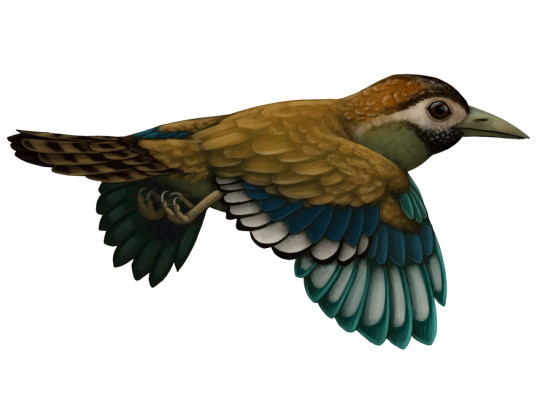
Eocoracias by @drawingwithdinosaurs
There were, of course, many tree dwelling birds in this lacustrine forest, including relatives from both sides of the "core landbirds" family tree. The ecosystem preserves a truly alarming number of mousebirds, including Chascacocolius with a conical beak, and Eoglaucidium with a strangely short tail. Eocoracias, another early roller like those found in Denmark, had iridescent feathers. Early hoopoes like Messelirrisor and early trogons like Masillatrogon show even more examples of more tropical birds showing up in higher latitude locations during this warm period. Messelastur was another possible Parrot/Passerine of prey; as was possibly Pumiliornis. Tons of pre-Passerines were here, too, including the zygodactly-footed Serudaptus, Psittacopes, and Primozygodactylus.
These dinosaurs were living at the end of a time of rapid evolution and diversification for most living things on Earth. However, the hot and humid times never last - as the planet begins to cool, drier ecosystems spread around the planet, and the global tropical forests fade into obscurity. It's time for these new groups of dinosaurs to adapt for new ecosystems...
Sources:
Mayr, 2022. Paleogene Fossil Birds, 2nd Edition. Springer Cham.
Mayr, 2017. Avian Evolution: The Fossil Record of Birds and its Paleobiological Significance (TOPA Topics in Paleobiology). Wiley Blackwell.
Smith, K. T. 2021. The Messel Pit: Window into a Greenhouse World. Geoconservation Research 4(2): 547-556.
119 notes
·
View notes
Text
Danielsraptor phorusrhacoides Mayr & Kitchener, 2022 (new genus and species)

(Skull of Danielsraptor phorusrhacoides [scale bar = 10 mm], from Mayr and Kitchener, 2022)
Meaning of name: Danielsraptor = [collector of the original fossil] Michael Daniels’s thief [in Latin]; phorusrhacoides = similar to phorusrhacids
Age: Eocene (Ypresian), 54.6‒55 million years ago
Where found: London Clay Formation, Essex, U.K.
How much is known: Partial skeleton of one individual including parts of the skull and limbs. A second partial skeleton including parts of the shoulder girdle and the end of the tail may also belong to this taxon.
Notes: Danielsraptor was a bird of prey, similar to but larger than Masillaraptor from the Eocene of Germany and the U.K. Masillaraptor had been previously suspected to have been closely related to modern falcons, but because previously described fossils of this genus were mostly preserved as flattened skeletons, their anatomical details were hard to discern. The three-dimensionally preserved material of Danielsraptor reveals several additional features that link these birds to falcons, including grooves along the biting surface of the upper beak (”tgr” in the figure above) and a projection in the back of the lower jaw (”prj” in the figure above). Danielsraptor and Masillaraptor were likely strong fliers and may have also been able to hunt on the ground, though their feet appear to have been less specialized for grasping prey than those of living falcons.
Interestingly, Danielsraptor also had a few traits in common with members of Cariamiformes (a group including the modern seriemas and the extinct phorusrhacids or terror birds), with its long, deep beak being especially similar to those of phorusrhacids. Genetic studies indicate that falcons and seriemas are fairly close relatives, so the distribution of features in Danielsraptor might indicate that a mixture of “falcon-like” and “seriema-like” characteristics was present in the last common ancestor of both groups.
Reference: Mayr, G. and A.C. Kitchener. 2022. New fossils from the London Clay show that the Eocene Masillaraptoridae are stem group representatives of falcons (Aves, Falconiformes). Journal of Vertebrate Paleontology advance online publication. doi: 10.1080/02724634.2021.2083515
50 notes
·
View notes
Photo
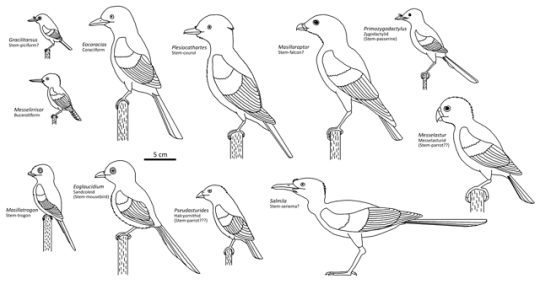
After forests recovered from their devastation by the Cretaceous mass extinction 66 million years ago, the few surviving dinosaurs quickly radiated into vacant arboreal niches. Among these new tree-dwelling birds, the most diverse were members of the clade Telluraves, a group that would give rise to hawks, owls, hornbills, kingfishers, woodpeckers, falcons, parrots, songbirds, and many more.
Here are a few 47-million-year-old telluravians whose fossils were found in the Messel Shale of Germany.
#Birds#Dinosaurs#Palaeoblr#Telluravians#Messelirissor#Gracilitarsus#Eocoracias#Masillatrogon#Eoglaucidium#Pseudasturides#Plesiocathartes#Masillaraptor#Salmila#Messelastur#Primozygodactylus
19 notes
·
View notes
Text
Danielsraptor vs Heracles
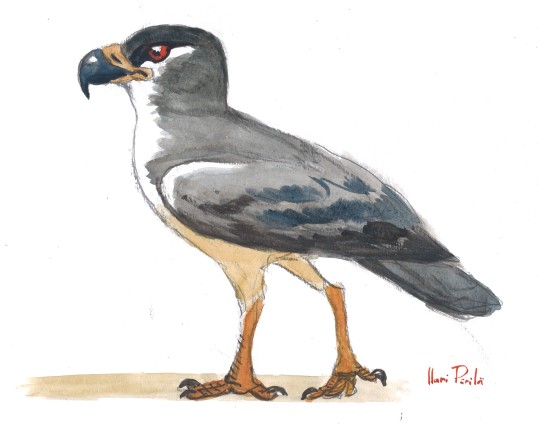

Factfiles:
Danielsraptor phorusrhacoides

Artwork by @otussketching, written by @zygodactylus
Name Meaning: Michael Daniels’ Terror Thief Bird
Time: 55 million years ago (Ypresian stage of the Eocene epoch, Paleogene period)
Location: Walton Member, London Clay Formation, England
While the Eocene fossil records of Seriemas, Passerines, and Parrots are fairly well known, the last remaining group of Australavians - the Falcons - remains something of a mystery. Danielsraptor helps to put together this puzzle a little more. Along with Masillaraptor, these birds show an early radiation of falcon-relatives from the Eocene in which they tried out a more terrestrial lifestyle! Danielsraptor had long legs, allowing it to forage and hunt on the ground like modern caracaras. It had a very large pygostyle, giving it long tail feathers - and with strong wing bones, it was able to fly in addition to hunt on the ground. It had a beak very similar to living caracaras and the extinct Terror Birds, further corroborating the idea that it was a bird of prey (and also potentially indicating a more complex evolutionary story for the early-derived Australavians). Living in the London Clay, Danielsraptor would have been one of the top predators, easily hunting the small mammals as well as the birds it shared its environment with - aided by both its terrestrial stalking abilities as well as its flying capability. Living in the London Clay, it shared its environment with the early loon Nasidytes, early owls, trogons, paleognaths, tropicbirds, duck-screamers, other diurnal raptors, the pseudotoothed bird Dasornis, and many parrot-passerine relatives. Crocodilians, snakes, turtles, fish, sharks, and a handful of mammals (including a primate) also lived in this rich post-Paleocene-Eocene Thermal Maximum environment.
Heracles inexpectatus

Artwork by @otussketching, written by @zygodactylus
Name Meaning: Unexpected Herculean Parrot
Time: 16 to 19 million years ago (Burdigalian stage of the Miocene epoch, Neogene period)
Location: St. Bathans Fauna, Bannockburn Formation, Aotearoa
Heracles was a truly alarmingly large parrot, related to modern day Kea, Kaka, and Kakapo, known from the fantastic avifauna of St Bathans. Standing more than two feet tall and weighing about fifteen pounds, this animal was much larger than any expected from the St Bathans fauna, which represented the initial colonization of Aotearoa (Zealandia) after it returned above sea level. Heracles is also the largest known species of parrot, ever. It was presumably flightless, though it is uncertain if it was nocturnal like its living relative the Kakapo. Its exact ecology is still uncertain, given the material known from Heracles is limited and its living relatives have very disparate ecologies, though it is possible it was omnivorous similar to the Kea and Kaka today. The St Bathans fauna lived in a freshwater lake system, in a subtropical emergent rainforest. Separated from land bridges, the fauna was dominated by birds, with early relatives of the Kiwi, New Zealand Wrens, Adzebills, and Wedge-Tailed eagles found in the fauna, as well as somewhat modern looking Moas. Smaller flamingos, large fruit pigeons, and a huge variety of geese and other waterfowl are known. In addition, frogs, tuataras, other lizards, crocodilians, turtles, and many different types of fish are known from this fascinating ecosystem.
DMM Round One Masterpost
#dmm#dinosaur march madness#dmm round one#dmm rising stars#palaeoblr#dinosaurs#paleontology#bracket#march madness#danielsraptor#heracles#polls
178 notes
·
View notes
Text
Palaeoglaux
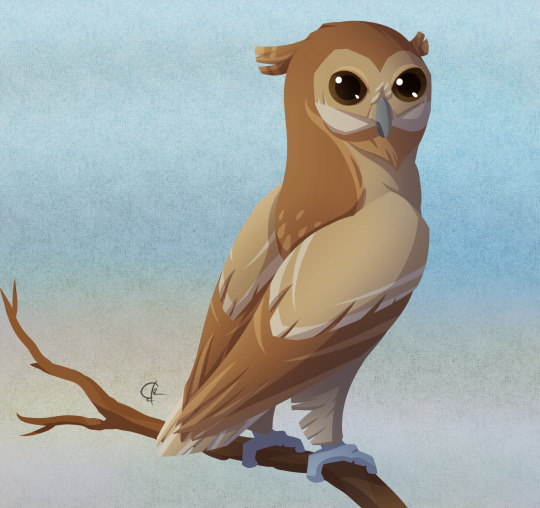
By José Carlos Cortés
Etymology: Ancient Owl
First Described By: Mourer-Chauviré, 1987
Classification: Dinosauromorpha, Dinosauriformes, Dracohors, Dinosauria, Saurischia, Eusaurischia, Theropoda, Neotheropoda, Averostra, Tetanurae, Orionides, Avetheropoda, Coelurosauria, Tyrannoraptora, Maniraptoromorpha, Maniraptoriformes, Maniraptora, Pennaraptora, Paraves, Eumaniraptora, Averaptora, Avialae, Euavialae, Avebrevicauda, Pygostaylia, Ornithothoraces, Euornithes, Ornithuromorpha, Ornithurae, Neornithes, Neognathae, Neoaves, Inopinaves, Telluraves, Afroaves, Strigiformes
Referred Species: P. perrierensis, P. artophoron
Status: Extinct
Time and Place: Palaeoglaux lived from 48 to 37 million years ago, from the Ypresian age to the Priabonian age of the Eocene in the Paleogene

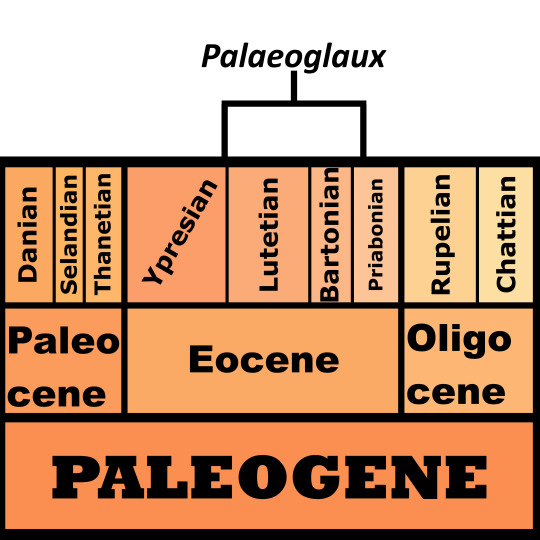
Palaeoglaux is known from the Messel Pit of Darmstadt-Dieburg, Germany; as well as the later Quercy Fissure Formation of Occitanie, France
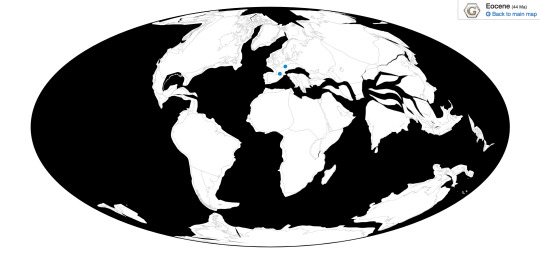
Physical Description: Palaeoglaux was a very early form of owl, and one of the most complete early owls known - which means we know quite a bit about it! It is known from multiple individuals, including full skeletons on slabs; though, at this time, its skull is not known, so it is uncertain if it looked quite as weird as living owls in terms of facial structure. Like living owls, it has extra air holes in its shoulders, showing that this unique trait of living owls evolved very early on. However, it doesn’t show a bony arch in the foot like living owls, meaning it probably didn’t use its feet as much in hunting as living owls do - since that bony arch helps to strengthen the feet in gathering prey.
In general, Palaeoglaux was a fairly small owl, about the size of the modern Little Owl - so, able to fit in the palm of the hand. This makes sense, given that most animals from the global rainforest of the Messel Pit were quite small, due to the density of vegetation. In addition, the later species - from the late Eocene, when the rainforest was transitioning to drier, more open environments - is significantly larger than the earlier species, thus pointing to its size being directly related to its environment. One distinctive thing about Palaeoglaux, at least the earlier Messel species, are its feathers - long, ribbon like feathers are known from its back, which were originally interpreted as display structures. This would have made Palaeoglaux a rare, but not unique, example of a diurnal (daytime) owl. However, these sorts of feathers are actually quite common in Messel Pit fossils - so it actually could be an example of a preservational thing. Thus, more fossils are necessary to determine if these feathers are actually a display structure or just regular old feathers. Since there are many diurnal birds of prey in the Messel Environment, it would make sense for there to be at least one nighttime hunter such as Palaeoglaux. Still, the jury is out.
Diet: As an owl, Palaeoglaux was probably a bird of prey - feeding on small animals such as rodents, lizards, and smaller birds. Still, we do not have the head of Palaeoglaux at this time; this means we can’t be certain that it was exclusively carnivorous, like modern owls. It is more likely because the common ancestor of owls and many other birds such as mousebirds, rollers, parrots, and songbirds was probably a bird of prey; so owls (and animals like hawks, eagles, falcons, and seriemas) just retained that lifestyle while other groups lost it. Still, it’s possible Palaeoglaux may have had a different diet than living owls, and more fossils are necessary to confirm that it was a predator. Given that Palaeoglaux was quite small in the Messel environment, it wouldn’t have been able to eat very big animals; though its prey size would have increased as it did later in the Eocene.
Behavior: Owls today utilize keen eyesight and hearing to hunt food at night, using silent flight to sneak up on prey and catch them unawares. Many of the features necessary for this probably evolved in the Eocene, as some of the earliest representatives of modern owls evolved in this time. However, Palaeoglaux shows a unique mixture of early and derived traits, and thus, it may not have been ask exceptionally adapted for hunting as living owls. Much of Palaeoglaux’s behavior remains a mystery because we do not have fossils of its head at this time - and we’re not sure whether or not it was diurnal, meaning active in the day, or nocturnal, aka active at night.
Given that it does have more air-filled shoulder bones, it probably was in the process - if not already there - of evolving those silent flight mechanics of living owls. This would have aided it in hunting prey, allowing it to sneak up on other animals. However, its less strengthened toe bones would mean that it wasn’t quite as good at holding down its prey and catching it with its feet as living owls; it possible that it would have used its mouth more, though of course, without head fossils that’s difficult to say. Still, it would have dwelled in trees, using its high vantage point to look for food.
If Palaeoglaux’s ribbon feathers were for display, rather than just regular feathers, then Palaeoglaux would have probably been diurnal - active and hunting during the day. It may have puffed up those ribbon feathers in threat displays or sexual displays as well. If they weren’t for display, Palaeoglaux may have still been diurnal; or it could have been nocturnal, hunting small animals at night.
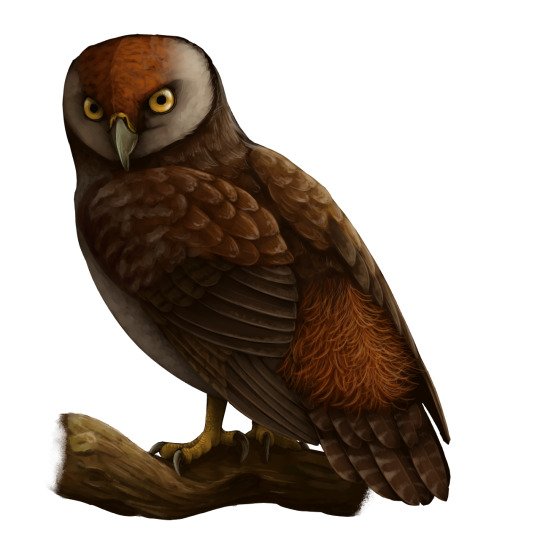
By Scott Reid
Ecosystem: The Messel Pit was a diverse and important ecosystem from the middle Eocene, with many different transitional forms of animals to showcase how life began to evolve into modern forms. Palaeoglaux is one of many transitional dinosaurs, living in the Global Rainforest environment of the time; the Messel Pit was warm and wet and covered with dense vegetation, which rendered Palaeoglaux and essentially all other tree-dwelling birds extremely small. The forest surrounded a large lake, which was filled with trapped volcanic gas; these gases would have released periodically and overwhelmed the animals of the environment, leading ot mass deaths. These animals would have then drifted down to the bottom of the lake, allowing for the unique preservation that allows for us to have a unique glimpse into this environment. Palaeoglaux probably spent most of its time in the trees, rather than closer to the lakeshore.
Many other dinosaurs filled the environment with Palaeoglaux, including the early roller Eocoracias, the early songbird Primozygodactlyus, other roller and Kingfisher relatives Messelirrisor and Primobucco, the parrot of prey Messelastur, the seriema-like Strigogyps, and the large herbivore Gastornis. Messelastur and Strigogyps, being much, much larger than Palaeoglaux, may have even fed upon it. The early flamingo relative Juncitarsus was also present in the pit, and probably was a wading bird within the lake of the Messel. Early forms of hummingbirds and other weird fliers were present (such as early relatives of potoos and nightjars), as well as an early woodpecker relative Gracilitarsus, other seriema relatives like Idiornis, and falcons like Masillaraptor. As such, diurnal birds of prey were heavily present in the Messel; and this points more to Palaeoglaux potentially being nocturnal after all.
Palaeoglaux was also present in the Quercy Fissure Formation. This was a later Eocene formation, showcasing how life began to transition along with the general environment. The global rainforest was drying up as the world was cooling; ice caps were forming at the poles, and ecosystems in general were becoming more open, dry plains. As such, Palaeoglaux got somewhat larger - as did other birds. Still, the Quercy Formation represents an environment that was still fairly warm and wet - it was probably an estuary environment, near to the shore but not quite associated fully, given that very few fish are preserved there. The environment was littered sinkholes and caves, leading to its unique preservation of animals. Many salamanders and some frogs are known form the area; though, by far, lizards are some of the most common animals there, and were probably a major source of food for Palaeoglaux. Here, Strigogyps was still present, and may have still been a problem for Palaeoglaux; parrots closer to modern forms such as Quercypsitta were present, as was the early woodpecker relative Sylphornis. Pigeons, water birds, and landfowl were also common frequenters of this environment.
Other: Palaeoglaux, though complete, is often extremely crushed; the fossil slabs of the species are difficult to interpret, and one of the best known slabs has not yet been fully described.
Species Differences: P. perrierensis is the later species from Quercy - so it is younger, from France, and larger than P. artophoron, the species from the Messel. In addition, P. perrierensis did have somewhat stronger feet than P. artophoron, indicating further evolution of traits involved in catching prey as the genus continued through the Eocene.
~ By Meig Dickson
Sources under the cut
Astruc, J. G., G. Escarguel, B. Marandat, R. Simon-Coinçon, B. Sigé. 2000. Floor-age constraining of a tectonic paroxysm of the Pyrenean orogen. Late Middle Eocene mammal age of a faulted karstic filling of the Quercy phosphorites, south-western France. Geodinamica Acta 13: 271 - 280.
Mayr, G. 2009. Paleogene Fossil Birds. Springer-Verlag Berlin Heidelberg.
Mayr, G. 2017. Avian Evolution: The Fossil Record of Birds and its Paleobiological Significance. Topics in Paleobiology, Wiley Blackwell. West Sussex.
Mayr, G. 2016. The early Eocene birds of the Messel fossil site: a 48 million-year-old bird community adds a temporal perspective to the evolution of tropical avifaunas. Biological Reviews 92 (2): 1174 - 1188.
Mezger, J. E., M. Felder, F.-J. Harms. 2013. Crystalline rocks in the maar deposits of Messel: key to understanding the geometries of the Messel Fault Zone and didatreme and the post-eruptional development of the basin fill. Journal of the German Geosciences Society 164 (4): 639 - 662.
Mourer-Chauviré, C. 1987. The owls (Aves: strigiformes) of Phosphorites Du Quercy (France) systematics, biostratigraphy, and paleobiogeogrpahy, pgs 89 - 136 in Documents des Laboratoires de Geologie Lyon, Départment des Sciences de la Terre, Université Claude-Bernard Lyon 1.
Peters, D. S. 1992. A new species of owl (Aves: Strigiformes) from the Middle Eocene Messel Oil Shale. Campbell, K. ed. Papers in Avian Paleontology honoring Pierce Brodkorb. Science Series Natural History Museum of Los Angeles County 36: 161 - 169.
Rage, J.-C. 2006. The Lower Vertebrates from the Eocene and Oligocene of the Phosphorites du Quercy (France): An Overview. Strata 1 (13): 161 - 173.
#palaeoglaux#bird#dinosaur#owl#paleogene#carnivore#eurasia#theropod thursday#birds#dinosaurs#afroart#factfile#birblr#palaeoblr#palaeoglaux perrierensis#palaeoglaux artophoron#paleontology#prehistory#prehistoric life#biology#a dinosaur a day#a-dinosaur-a-day#dinosaur of the day#dinosaur-of-the-day#science#nature
177 notes
·
View notes
Note
Are Horusornis & Masillaraptor closer to falcons or hawks?
Neither of them have been included in a phylogenetic analysis, but Mayr (2009) suggested that the anatomy of Masillaraptor is most consistent with that of falcons. There hasn’t been a recent assessment of Horusornis, though (as I previously noted) Mayr mentions “possible accipitrid affinities” in his book Avian Evolution.
1 note
·
View note
Note
Is Coturnipes still considered a raptor (as in Mayr 2006)?
More recently, Mayr and Smith (2019) reexamined Coturnipes and considered close affinities to Masillaraptor (as Mayr originally suggested) unlikely. It’s still unclear what it actually was though.
1 note
·
View note